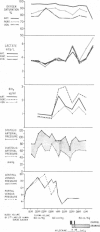Abstract
Perumbilical portal vein catheters and arterial and central venous catheters were inserted in 16 patients recovering from trauma or other shock-producing events, and in 5 patients who later developed shock. This permitted serial measurement of blood gases, pH, and the levels of ammonia, lactate and certain other metabolites in all three circulatory systems simultaneously. Nine of the trauma patients were never in shock, had no liver disease or injury and consequently formed a baseline group for comparison with the shock patients. In the shock patients there was a significant degree of hypoxemia in the portal venous blood and an increase in the arterialportal oxygen saturation difference. Their portal venous blood showed a lower pH and a higher pCO2 than did the portal blood of the patients who had never been in shock. In 3 of the 4 shock patients who died, the total blood lactate showed a greater increase in portal venous than in the arterial or central venous blood. In shock there was also an increase in portal venous blood ammonia which was later accompanied by increments in arterial and central venous blood ammonia. This suggests impairment of hepatic urea synthesis, allowing escape of ammonia through the liver. These phenomena, when added to the finding previously reported of an elevated portal venous pressure in some shock patients, lend support to the hypothesis that in certain cases of shock there is increased impedance to flow of portal blood through the liver with resultant stasis in the portal-splanchnic bed and ischemichypoxic hepatocellular injury.
Full text
PDF








Images in this article
Selected References
These references are in PubMed. This may not be the complete list of references from this article.
- BAYLY J. H., CARBALHAES O. G. THE UMBILICAL VEIN IN THE ADULT: DIAGNOSIS, TREATMENT AND RESEARCH. Am Surg. 1964 Jan;30:56–60. [PubMed] [Google Scholar]
- BIERMAN H. R., WHITE L. P., KELLY K. H., STEINBACH H. L. Biochemical and hematologic characteristics of blood from the hepatic portal vein in man. J Appl Physiol. 1953 Apr;5(10):567–576. doi: 10.1152/jappl.1953.5.10.567. [DOI] [PubMed] [Google Scholar]
- Cowley R. A., Attar S., LaBrosse E., McLaughlin J., Scanlan E., Wheeler S., Hanashiro P., Grumberg I., Vitek V., Mansberger A. Some significant biochemical parameters found in 300 shock patients. J Trauma. 1969 Nov;9(11):926–938. doi: 10.1097/00005373-196911000-00003. [DOI] [PubMed] [Google Scholar]
- GONZALEZ CARBALHAES O. Portography: a preliminary report of a new technique via the umbilical vein. Clin Proc Child Hosp Dist Columbia. 1959 May;15(5):120–122. [PubMed] [Google Scholar]
- GRAYSON J., MENDEL D. The role of the spleen and the hepatic artery in the regulation of liver blood flow. J Physiol. 1957 Apr 3;136(1):60–79. doi: 10.1113/jphysiol.1957.sp005743. [DOI] [PMC free article] [PubMed] [Google Scholar]
- HANKINS J., BESSMAN S., MANSBERGER A., COWLEY R. A. The origin and utilization of ammonia in shock: a comparison of the levels of blood ammonia in the portal and systemic circulation during shock induced by the Fine Technique. Bull Soc Int Chir. 1959 Mar;18(1):20–30. [PubMed] [Google Scholar]
- Hankins J. R., Cowley R. A., Zipser M. E., Turney S. Z. Use of the umbilical vein for manometric and radiographic studies of the splanchnic and portal beds in shock and trauma. Ann Surg. 1972 Jul;176(1):111–119. doi: 10.1097/00000658-197207000-00020. [DOI] [PMC free article] [PubMed] [Google Scholar]
- JOHNSON D. H. The effect of haemorrhage and hypotension on the liver blood flow. J Physiol. 1954 Dec 10;126(3):413–433. doi: 10.1113/jphysiol.1954.sp005219. [DOI] [PMC free article] [PubMed] [Google Scholar]
- Kaplan A., Davies J. I., Field M. The hemodynamic bisection of the liver. Surgery. 1969 Aug;66(2):357–367. [PubMed] [Google Scholar]
- Kock N. G., Roding B., Hahnloser P., Tibblin S., Schenk W. G., Jr The effect of glucagon on hepatic blood flow. An experimental study in the dog. Arch Surg. 1970 Feb;100(2):147–149. doi: 10.1001/archsurg.1970.01340200035008. [DOI] [PubMed] [Google Scholar]
- SHOEMAKER W. C., SZANTO P. B., FITCH L. B., BRILL N. R. HEPATIC PHYSIOLOGIC AND MORPHOLOGIC ALTERATIONS IN HEMORRHAGIC SHOCK. Surg Gynecol Obstet. 1964 Apr;118:828–836. [PubMed] [Google Scholar]
- SHOEMAKER W. C., VAN ITALLIE T. B., WALKER W. F. Measurement of hepatic glucose output and hepatic blood flow in response to glucagon. Am J Physiol. 1959 Feb;196(2):315–318. doi: 10.1152/ajplegacy.1959.196.2.315. [DOI] [PubMed] [Google Scholar]
- Storti E., Lusvarghi E., Lenzi M., Gibertini G., Torricelli A., Zambarda E., Prati P. L., Fontana G., Rivi A., Montanari C. Le cathétérisme portal. Porto-manométrie et porto-hépatographie trans-omblilicale: remarques physiopathologiques et cliniques. Presse Med. 1966 Jan 26;74(5):207–212. [PubMed] [Google Scholar]
- TYGSTRUP N., WINKLER K., MELLEMGAARD K., ANDREASSEN M. Determination of the hepatic arterial blood flow and oxygen supply in man by clamping the hepatic artery during surgery. J Clin Invest. 1962 Mar;41:447–454. doi: 10.1172/JCI104497. [DOI] [PMC free article] [PubMed] [Google Scholar]
- White J. J. Direct portal hepatography and metabolic studies via the reopened umbilical vein. Effect of vasoactive drugs on portal pressure, blood gases and lactates. Am Surg. 1968 Dec;34(12):852–859. [PubMed] [Google Scholar]




